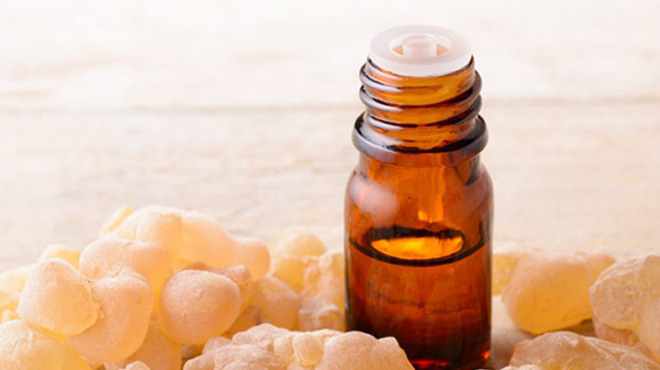Frankincense (Boswellia carterii) co2 oil extract
Botanical Name: Boswellia carteri Birdw. (synonym of Boswellia sacra Flueck.)
Plant Part: Resin
Use: Aromatherapy / Natural Perfumery / Incense. Always dilute.
Aroma Families: Resinous, Woody
Aroma: Warm, sweet balsamic, dry woody/resinous, very smooth, with a slightly peppery undertone and clear lemon and pine-like top notes.
Frankincense Carterii CO2 Select Extract is extracted from a Middle Eastern or African tree’s gum resin. It has the ability to rejuvenate the look of mature skin and can be used in creams for the face. The properties of Frankincense Carterii CO2 Select Extract make it ideal for joint pain associated with aging or overuse. It is also a marvelous choice when breathing is affected by seasonal threats and can be used to help support the respiratory system. Frankincense Carterii CO2 Select Extract can also be helpful during times of grief and sorrow.

Frankincense
The name of traditional Chinese medicine is the frankincense tree of the olive family and the resin of the same genus. The resin exuded from the bark.

It is divided into Somali frankincense and Ethiopian frankincense. Each frankincense is divided into frankincense beads and original frankincense.
how to extract oil from frankincense resin
how to extract frankincense oil
Pulverization degree:20 mesh
Extraction pressure: 30 MPa
Extraction temperature: 55°C
Separation pressure I: 8 MPa
Separation I temperature: 50°C
Separation pressure II: 5 MPa
Separation II temperature: 45°C
Extraction time: 90 min
The supercritical CO2 extraction process of frankincense oil
Frozen frankincense, crushed (20 mesh), weighed a certain amount into the 1 L extraction kettle, heated the extraction kettle and the analysis kettle to reach a predetermined temperature, fed CO 2 gas at a certain flow rate, adjusted the pressure of each kettle, and then started cyclic extraction.
The pressure of desorption vessel I is (8.0 ± 0.5) MPa and the temperature is 50 ℃; the pressure of desorption vessel II is (5.0 ± 0.5) MPa and the temperature is 45 ℃ . This condition remains unchanged in each experiment.
The experiment was carried out according to the orthogonal design, and the extraction rate of frankincense oil was used as the evaluation index, the influence of the level of various factors on the extraction effect was investigated, and the optimal process conditions were obtained.
How to get the optimization CO2 extraction process?
Extraction pressure
The main factors affecting the yield of Boswellia volatile oil in supercritical extraction are the pressure of the extraction tank, the temperature of the extraction tank and the extraction time.
The effect of extraction kettle pressure on the yield of frankincense oil. The extraction temperature was set to 50 ℃, and the extraction time was 1.5 h. The pressure effect was investigated. There were significant differences between the levels of extraction kettle pressure. However, from the actual consideration of production, the extraction pressure was finally determined to be 30 MPa.
Temperature
Set the pressure of the extraction kettle to 30 MPa and extract for 1.5 h. Check the pressure and temperature.
The higher the temperature, the better the extraction of frankincense oil. This is because temperature increase accelerates the movement of frankincense oil molecules, decreases viscosity, and increases fluidity, which is conducive to the dissolution and diffusion of frankincense oil.
There is no significant difference between the extraction conditions at 55 ℃ and 60 ℃, so the extraction temperature is determined to be 55 ℃.
Time to extract
Based on the above experimental research, the pressure of the extraction kettle is set to 30 MPa, the temperature is 55 ℃, and the optimal extraction time is preferred.
After 1.5 hours of extraction, Boswellia serrata produces oil slowly, and there is no significant difference between extraction for 2 hours and 1.5 hours.
To save energy and increase efficiency, the extraction time is determined to be 1.5 h. From the above data, it can be concluded that the optimal process conditions are: the pressure of the extraction vessel is 30 MPa, the temperature of the extraction vessel is 55 ℃, and the extraction time is 1.5 h.
Optimal process verification experiment
Three batches of verification experiments were carried out according to the optimal process conditions. The yields of frankincense oil were 19.81%, 19.23%, 19.63%, and RSD = 1.52%. Experimental results show that the process is stable and feasible.
Boswellia medicinal materials are relatively viscous, and it can be crushed or frozen crushed after being frozen alone or together with other medicinal materials to improve production effic
Summary
In this paper, a single factor analysis experiment was used to optimize the supercritical extraction conditions of Boswellia serrata, combined with actual production requirements, taking into account production efficiency and production costs, and comprehensively determined the optimization supercritical CO2 extraction process of Boswellia serrata.
This process shortens the extraction time and greatly improves the production efficiency.
The supercritical CO2 extraction of frankincense essential oil is different from other medicinal materials. Since frankincense mainly contains oil and fat components, a large number of components will be dissolved in CO2 at the beginning of extraction.
If the CO2 extraction kettle is not fully preheated and the local temperature is low, it will dissolve in CO2 The resin composition analysis shows that it accumulates, blocks the extraction passage, and damages the CO2 extraction machine (the direct extraction of frankincense is particularly serious after freezing and crushing).
Pharmacodynamic experiments showed that the frankincense essential oil extracted by this optimization process can significantly reduce the number of chemical pain writhing times in mice caused by acetic acid (P <0.01), and significantly inhibit xylene-induced ear swelling in mice (P <0.01). Pharmacodynamics The research results prove that this process is feasible.